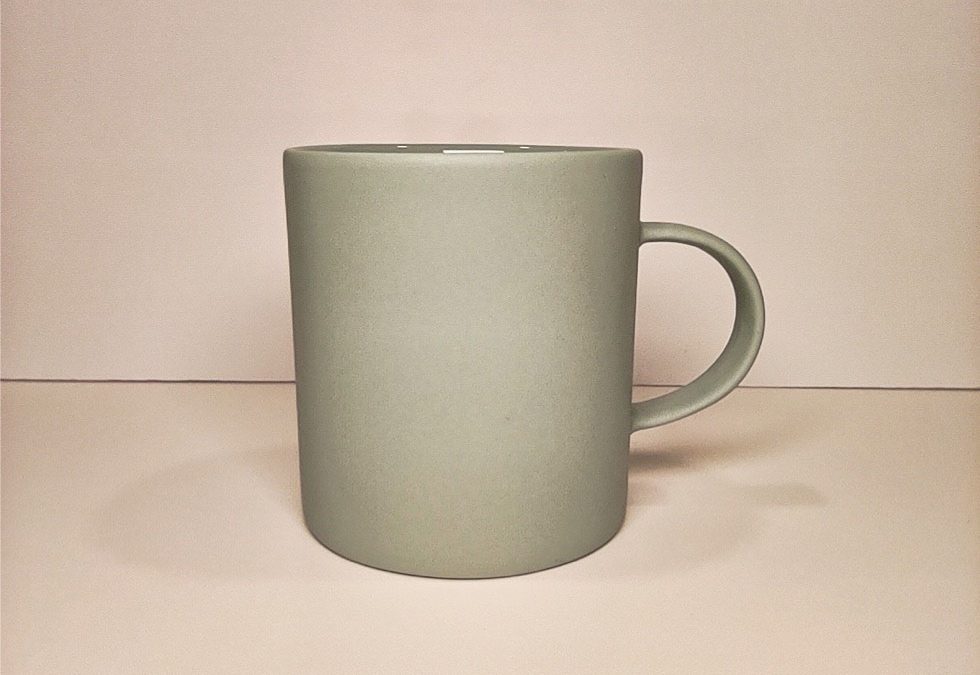For a good chunk of my life, little thought was given about the cup or mug coffee was served in. It was mostly seen as a ‘use what’s given to you’ kind of deal at establishments. And when it came to buying mugs for one’s self, the most appealing mug options at the local mall or department store were usually good enough.
The manner in which coffee is served in most restaurants, cafes and at home has largely been unremarkable and utilitarian. The cups and mugs did their job, and their function wasn’t really in question, but then again, nor was their form. Well, actually it was occasionally questioned, when encountering idiotic handle designs or when form really overtook function and drinking somehow became a frustrating experience.
But then, there’s that moment. That first time when you’re served coffee in a mug that makes you go “Oh wow, I really, really, like this mug.” Or even… “I don’t know if I can part with this mug.” You spend time marvelling and inspecting it’s features and literally coming to grips with it’s feel as you drink coffee from it. Prior to that moment, you’d probably come across the occasional mug that stood out, but nothing you’d personally connected with. It’s a sudden realisation that mugs can be more than just a standard issue affair, but actually has the ability to greatly influence the already loved ritual of drinking coffee.
What’s interesting, is trying to personally dissect what has created that response, it could be any number of things individually or in combination. It’s appearance, shape, texture, the in-hand feeling, weight, width of the rim, nostalgia value, its handmade craftsmanship, colour, the list is almost infinite. But one thing’s for sure, when the right mug hits the right chord, it transcends beyond simply serving as a vessel for containing and delivering liquids.
Whether it’s that very first amazing mug experience, or a few other encounters later, it likely kicks off a paradigm shift within you: mugs can be functional, beautiful and meaningful. There’s a realisation, that may be fact or pure psychology, that great coffee tastes even better from a great mug.
With all that in mind, let’s examine how mugs can vary so you can narrow down the characteristics of what may be the perfect mug for you.
Materials
The materials a mug is composed of is the major influencer of most everything else. There’s no better or worse material, they all have their own reason for being. Although having said that, there are some that for example have a greater longevity than others. This is apparent when you contrast thousand year old ceramic mugs on display in museums with cheap plastic mugs that struggle to make it through a few rounds in the dishwasher.

Clockwise: (Top) enamel metal mug, (Right) deep blue gloss interior, (Left Bottom) flat matt finish exterior.
Materials affect the feel, texture, weight, strength, scratch and wear resistance, transparency, thickness, colour, printability, porousness, reflectiveness, slipperiness, heat retention and so on. Heat retention is a major consideration since few of us are particularly fond of lukewarm coffee. Some materials like ceramic can admirably keep heat; while glass not so much, unless employing a double walled design to improve thermal performance.
I wouldn’t classify this chart as some sort of official materials breakdown; but rather how they’re likely grouped if purusing a typical assortment of mugs and cups at retailers.
NATURAL
Bamboo
Bone China
Ceramic
Glass
Porcelain
Stoneware
Terracotta
Wood
CHEMISTRY
Polycarbonate
Melamine
Acrylic
Polypropylene
METALIC
Enamel
Tin
Pewter
Stainless Steel
While perhaps debatable, natural materials like ceramic and stoneware are generally the preferred choice for coffee mugs. They best speak to the coffee drinking experience, with well suited characteristics like their in-hand feel, ideal weight, heat retention, durability and design versatility. While chemistry based mugs often resort to printing artwork on the surface; natural materials themselves like terracotta or stoneware are inherently beautiful; they can be styled to make best use of the material’s natural attributes, texture and richness.
Craftsmanship
You can have just as much of a connection with a mass produced acrylic mug that’s been shat from a factory that makes half the world’s mug supply, as you can with an artisanal handcrafted and painstakingly made mug. The mug a loved one gifted to you could be either and it’s that context that sets the scene for your connection and special bond with the mug.
Having said that, in searching for your own perfect mug, odds are higher that a well crafted mug that’s either been hand made with care and attention to detail, or one having been produced with authenticity and quality materials will likely fare better. There’s something about well crafted and unique objects that often leads us to have a greater bond and apprecaition for them.
While typically more costly and challenging to find well crafted mugs, they’ll certainly serve as a desirable partner in your daily coffee experience for a long time to come. It’s individual uniqueness, exacting fit to your desired characteristics, long term material endurance and possibly a more timeless design all add up to being an investment rather than an expense. If a middle of the road mug costs $10, but a well crafted and timeless piece you enjoy every sip from for years ahead cost $40, that initial outlay is a no-brainer.
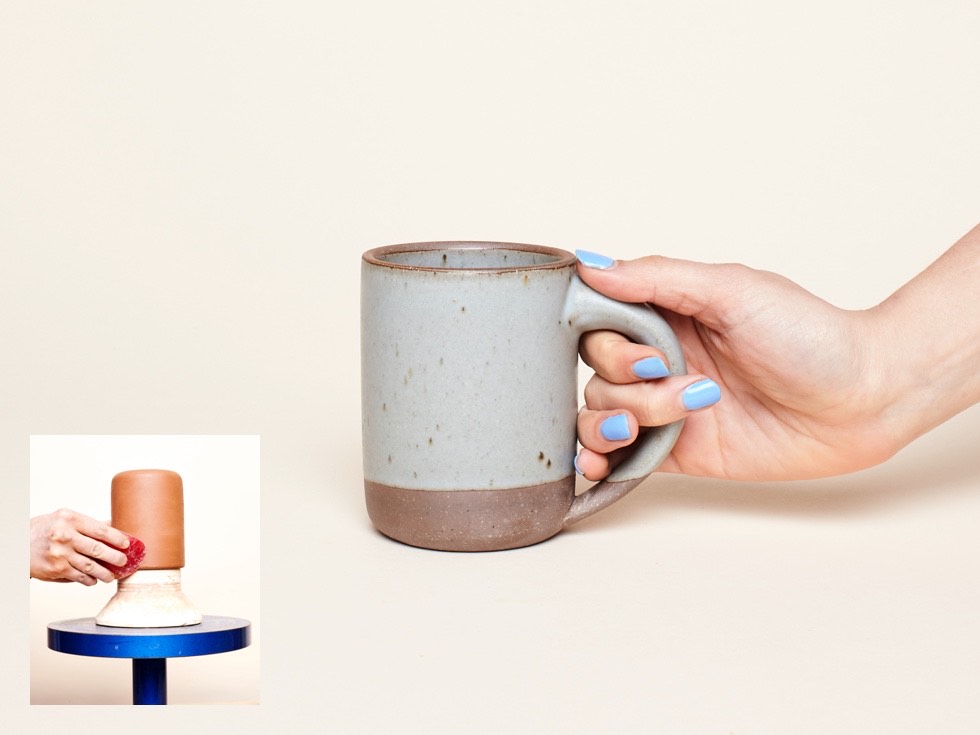
Above: East Fork’s Soapstone Mug with inset showing the hand made process of their mugs
An example of well crafted mugs is East Fork’s revered “The Mug”. Company Co-Founder Connie Matisse said “We took every element into consideration – the durability, how it rests in your hands, the aesthetic effect of its proportions. We put them in thousands of hands, drank thousands of cups of coffee, got feedback, made changes, got more feedback, made more changes.” Clearly showing that the creation of “The Mug” is a culmination of the intense study of its art, usability and experience.
Color and Pattern
I’ve always been a sucker for warm earthy palettes, stone and clay related colours, baby blues, gun metal greys and somehow deep orange – they all somehow relate to the coffee experience for me. What connects you best to your coffee experience? It’s worth pondering as it may not directly relate back to colours you’d generally associate as your favourites, but rather reflect your associations with drinking coffee.
Texture
Texture contributes greatly to the mug experience. While the interior of mugs is largely of a ‘polished’ finish for best compatibility with liquids; the exterior can have any level of finish from flat matt all the way up to a highly polished glaze. Some even use combinations of exterior textures to achieve their artistic styling.
Style
The style of your preferred mug may be influenced largely by your general preference such as modern, traditional, retro, vintage, antique or minimal. Look no further than the decor of your home, the place your perfect mug would likely reside. But keep in mind your perception of the coffee experience may be shaped differently and might not play along with your usual preferences.
For example my experience with Chinese teas. While I may generally like modern design themes, when enjoying tea I’m suddenly wanting authentic and traditional designs tracing back to the beverage’s roots and heritage, a long way from modern minimalist stylings.
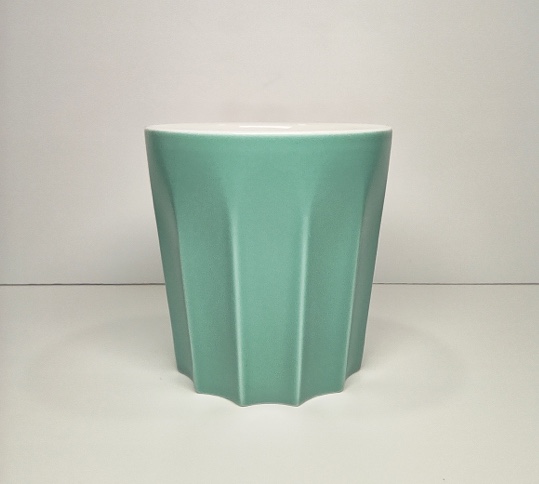
The Story
A mug I’d bought long ago was a rather stout, heavy in the hand, beige mug with a large crimson coloured “H” imprinted across it. It served as my go to mug when I really had to hunker down, think things through and try to have a moment of brilliance or break-through.
The mug was bought at the campus of Harvard University during a trip to Boston, hence the “H”. To me, not only did the “H” symbolise that great trip, but also the boggling amount of talent and hard work that would have graced the halls of such an establishment. The design of the mug itself is pleasant, if not a bit underwhelming, but it was the story of its acquisition and what it represents that made it particularly noteworthy. Consider the story behind the mugs you have or wish to acquire.
Shape and Size
If someone asks me “What size of coffee do you want?”, my immediate reply is “How big can we make get?” If that means it’s wheeled out from behind the counter, necessitates building permits or the use of large handles, so be it. With that in mind, finding large mugs is my thing. Whilst on a recent trip to the always incredible Japan, I’d been on the lookout for such an extra large mug, and in Japan when you’re looking for sumo sized mugs, that’s exactly what you’ll get.
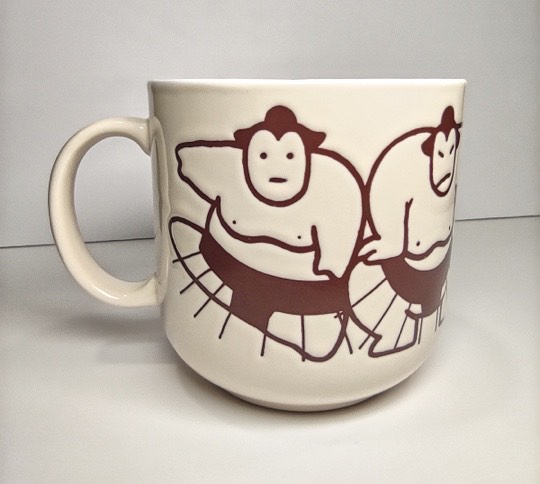
Your mug size requirements might be totally different. Perhaps your thing is slapping back an espresso shot before bolting to work in the morning. Then you’re looking for that perfectly pint-sized espresso cup that speaks to that moment.
It’s worth considering that size and shape also impact hand feel, weight and that some styles of coffee are traditionally served in mugs of particular parameters. The cup a Cappuccino is served in often differs to a Latte or Americano, each coffee style has a cup that best fits its characteristics. This can also affect their height, with some beverages being served in long slender cups and others in short wide cups.
With shape and size, the mug’s wall thickness should also to be considered. There’s chunky and weighty, where there’s a decidedly heavy substantial feel, the walls are deep with an often thick base. There’s a common ‘standard’ thickness that many millions of ceramic mugs fit into as the ideal middle ground that best speaks to durability, weight and heat retention. Then finally thin walled mugs, which often sit in the realm of hand made and artistic mugs. At the lesser extreme of ‘thin’ there can be a unique sense of weight and feel in the hand. Less conventionally, more artistic mugs take the thinness to extremes which may have a certain appeal to some, but fragility can be concerning.

Handle
Closed handle mugs are by far the most popular, but there’s also open handle mugs where a full loop is not present. Handles come in a variety of forms that resemble the letters “C”, “D” and “O”, and some that are crafted artistically. There’s also mugs with no handle at all, such as tumblers. While that may seem inconvenient, depending on their design, they can in fact be quite ergonomic and satisfying to use.
Much of the “usability” of a mug comes down to the compatibility of its handle design with your hand. As someone with large hands, mugs sporting tiny handles that necessitate finger squeezing each use is impractical; likewise someone with small hands needing to balance a full mug with a cavernous handle is also problematic.
It’s easy to get caught up in the design or pattern of the mug and completely overlook it’s usability, so doing some “mock runs” to test its ease of use is well worth it if possible.

Branded
When living in Hanoi, Vietnam there was a fantastic cafe I frequented called All Day Coffee. Besides the name having a striking resemblance to my coffee drinking habits, it was always a delightful experience. For the times I wasn’t at their cafe, their well designed branded red mug served almost as an extension of those wonderful cafe moments in my home. It’s as though I had a little portable piece of those memorable cafe experiences.
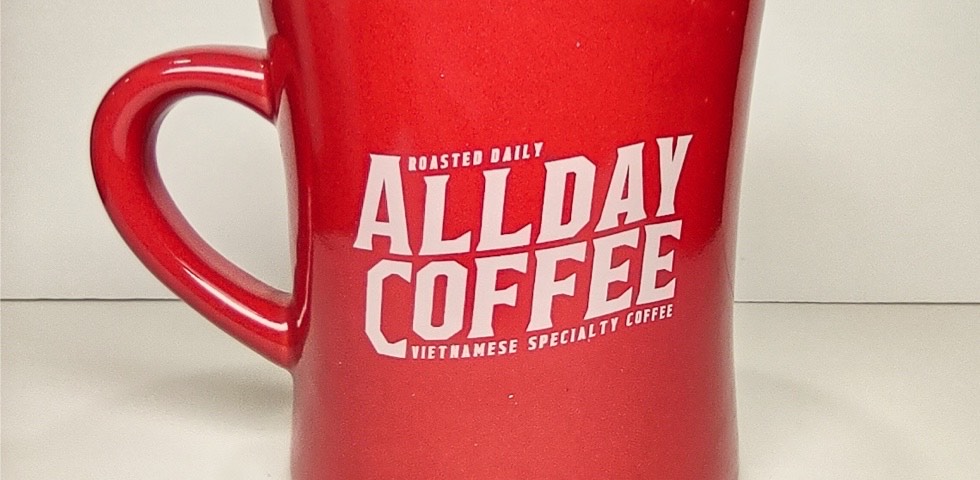
Above: The chunky All Day Coffee mug has substantial weighting and striking red color.
Branded mugs have also started to evolve beyond simply being a generic mug stamped with a logo. For example, the Phuc Long coffee franchise established a location within the modern sprawling Ho Chi Minh campus of a large technology company. To commemorate this, they produced a mug that was not only branded with their logo, but featured illustrations and references to the technology campus itself.

Above: Evolution of The Coffee House branded mugs including standard and signature range.
The Coffee House franchise produced a beautiful piece that artfully depicts the farm to cup journey in a tastefully drawn illustration. Coffee House Signature, their upscale offering, features a mug with modern black and white patterns impressed into the ceramic for greater impact and tactile feel.
Wrap Up
With the rise of people discovering the joys of coffee making at home, finding a perfect mug to accompany that experience really makes sense. Likewise for those in work environments, having your own special mug rather than depending on that often sad bunch of mugs in the office pantry is a no-brainer. The exploration of finding great mugs is somewhat part of the overall mug experience, be adventurous and go behind your normal retail stomping grounds and you be be rewarded with something unique, meaningful and an enjoyable part of your coffee experience.

